Scientific Name
Pogostemon cablin (Blanco) Benth
Synonyms
Mentha auricularia Blanco, Mentha cablin Blanco, Pogostemon battakianus Ridl., Pogostemon comosus Miq., Pogostemon javanicus Backer ex Adelb., Pogostemon mollis Hassk., Pogostemon patchouly Pellet., Pogostemon tomentosus Hassk. [1]
Vernacular Name
| Malaysia | Nilam [2][3], dhalum wangi, tilam wangi [2][4] |
| English | Patchouli, patchouli oil plant [5] |
| China | Guang huo xiang [2][3] |
| India | Pachi (Sanskrit); pachauli (Hindi); pachapat, patchouli (Bengali); pachila, kattam (Malayalam); pachetene (Kannada); pacha, sugandhi pandi (Gujarati); panch (Marathi) [2] |
| Indonesia | Nilam wangi (General); nilam (Acheh); singalon (Batak) [2][4] |
| Thailand | Phimsen (Bangkok) [2] |
| Vietnam | Hoac huong, quang hoac huong [5] |
| Philippines | Kabling (Tagalog); katluen (Bisaya); kadlum (Bikol, Bisaya, Sulu) [5] |
| Korea | Hyangdulkkaephul [2][3] |
| France | Patchouli [2][4] |
| Spain | Pacholi [2][6], pachulí [3]. |
Geographical Distributions
Pogostemon cablin possibly originated from the Philippines [3] and is found mainly in the Philippines islands [7]. This plant is widespread and naturalised in South East Asia, southern China, India, Sri Lanka, Mauritius and Florida [8].
Botanical Description
P. cablin is a member of the Laminaceae family. It is a herbaceous, erect plant, many branches and a pubescent aromatic herb. It can grow up to 1 m high. [9][10]
The stem is square or rectangular shaped with swelling at the nodes. The stems are covered with fine hair with slightly purple in colour [9][10]. In Malaysia, this plant does not produce flowers [9].
The leaves are ovate, 8-10 cm long, 5-8 cm wide, thick and curly. The leaves are dark green to purplish and produce a unique aroma. [9]
The leaves are oval in shape measuring about 10 cm long and wide, serrated with dotted glands beneath the leaves. The petiole is about 8 cm long. [10]
The inflorescence spike, terminal or axillary, densely arranged, measuring 8-15 cm long. The flowers are very small, irregular, bisexual, hypogynous. The calyx measures 5-6.5 mm long, the corolla lobes obtuse measuring 6-9 mm, with white and purple colour blotched on all parts. The filaments violet and bract present; as long as the calyx. [10]
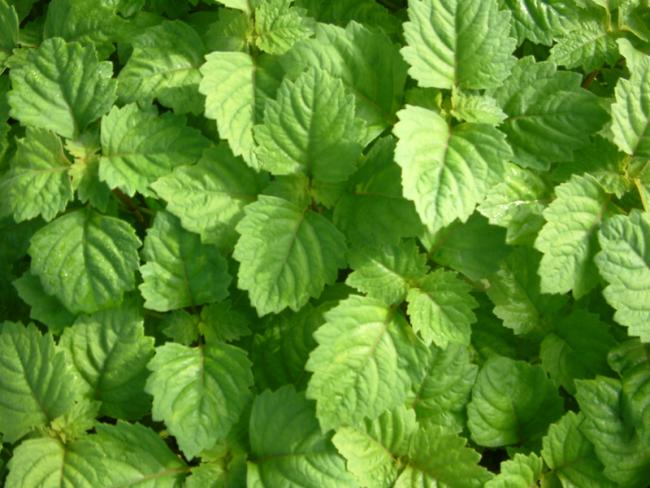
Cultivation
P. cablin is usually are grown for its essential oil. The essential oil is found in all parts of the plant, but the high quality of oil is coming from the top leaves and tender twigs and its quality improved with age. The high quality of P. cablin essential oil emitted a soft, fruity, rich musky-sweet, strong spicy and herbaceous smell. It is also a long-lasting oil. [11]
Soil Suitability and Climatic Requirement
P. cablin survives well in tropical climate having a well distributed rain throughout the year with total annual rainfall of 1,500–2,500 mm and no long dry span. In general, P. cablin grows well on various soil types as long as the soil is fertile, friable and with a good drainage. [9]
Field Preparation
Land Preparation
Land preparation is done before the onset of rain. One round of disc plough followed by two rounds of rotovation is sufficient to obtain a friable soil. [9]
Production of Planting Materials
P. cablin can be propagated using stem cuttings. The stem is taken from vigorous and mature plants of about 8-9 months old in the field. Stem cutting of about 15 cm long with 3−5 nodes is usually used. The cutting is raised in the polybag (10 cm x 15 cm) filled with soil mixture consisting of soil and sand in the ratio of 2:1 to induce rooting. After two months, the rooted cuttings with leaves/leaflets are ready for field planting. [9]
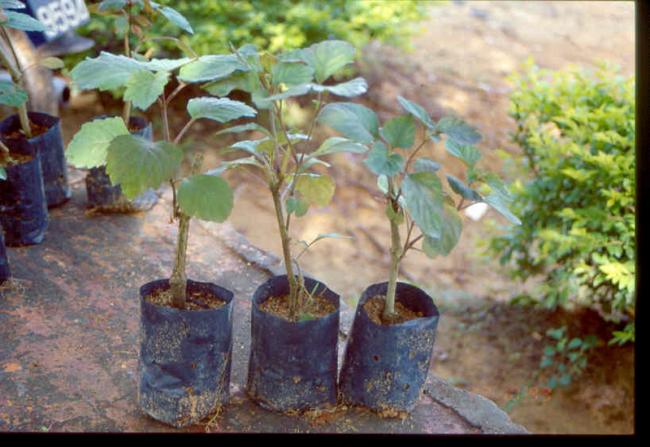
Field Planting
P. cablin is recommended to be planted at a planting density of 20,000 plants/ha with planting distance of 1.0 m between rows and 0.5 m between plants within a row. Planting is done at the onset of rain. [9]
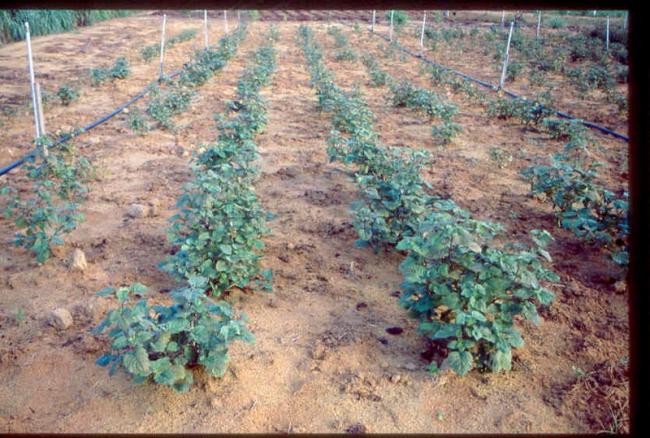
Field Maintenance
Fertilisation
P. cablin requires high amount of fertiliser for good growth and high yield. The recommended fertiliser rate is 180 kg N/ha, 90 kg P2O5/ha and 120 kg K2O/ha. The fertiliser is divided into four equal parts and applied on the 1st, 2nd, 3rd and 4th month after field planting. For ratoon crop, the fertiliser is applied during the 1st, 2nd and 3rd month after the harvest of main crop. [9]
Weed Control
Weed control is done as early as during land preparation. At the early growth stages, manual weeding is done around the plants and interrow cultivation. Contact herbicides can be used to control the weeds between the rows. [9]
Water Management
Sufficient water supply is very crucial for good growth and high yield of P. cablin. Irrigation is needed during the first month of crop establishment. The plants have to be watered every day if there is no rain. Watering is reduced to every 2-3 days for the established crops (2 months after field planting). Sprinkler irrigation system is recommended. [9]
Pest and Disease Control
In general, there was no main pest for P. cablin reported. For the disease, it was reported that P. cablin attacked by `buduk’ causes the leaves to become curly and die. The cause of this disease is not known but to avoid them it is recommended to use vigorous, disease-free planting materials and practise good crop management. [9]
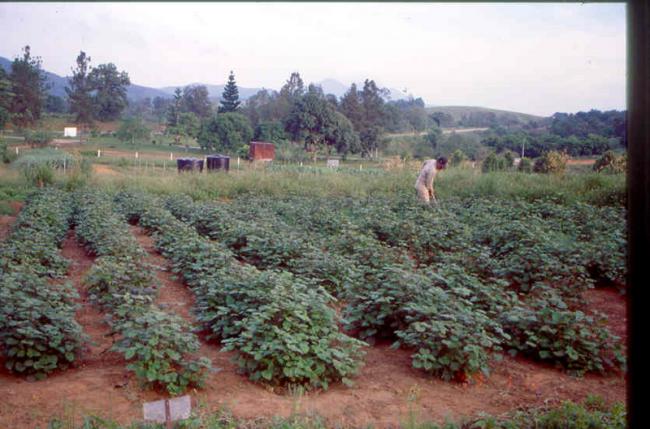
Harvesting
P. cablin can be harvested after 6−7 months planting in the field. The yield of fresh leaves is 30 t/ha. Harvesting is done manually by cutting the branches at 15−20 cm above the ground. About 2−3 branches are left to remain on every plant. This is to enhance the growth of subsequent new branches. The harvest is done carefully by using secateurs or shears to ensure the plant is not pulled out that may damage the roots. Cutting harshly may disturb the roots and consequently the plant will dry and die. Ratoon crop is harvested at 3−4 months after the harvest of the main crop. The yield of fresh leaves is 18−20 t/ha. Observation showed that the yield of ratoon crop dropped drastically after the first ratoon. Therefore, P. cablin is recommended to be replanted after the second harvest. Harvesting is done in the early morning when the P. cablin leaves contain optimum amount of oil. [9][12]
Postharvest Handling
After harvesting, the leaves are normally dried for 4-5 hours under the sunlight. Proper drying is needed to ensure the quality of oil is maintained. Subsequently, the leaves are air-dried under the shade for 3-4 days before distillation. The water content of leaves should be maintained below 15%. The ratio of fresh leaves to dried leaves is 5:1 or about 20%. The dried P. cablin leaves can be stored in gunny sacks for quite some time before distillation. Distillation process takes about 5-6 hours. The yields of extracted oil from P. cablin leaves are about 0.65% of the fresh leaves. One hectare of P. cablin can produce 195 kg of extracted oil from the main crop and 117-130 kg from the ratoon crop. [9][12]
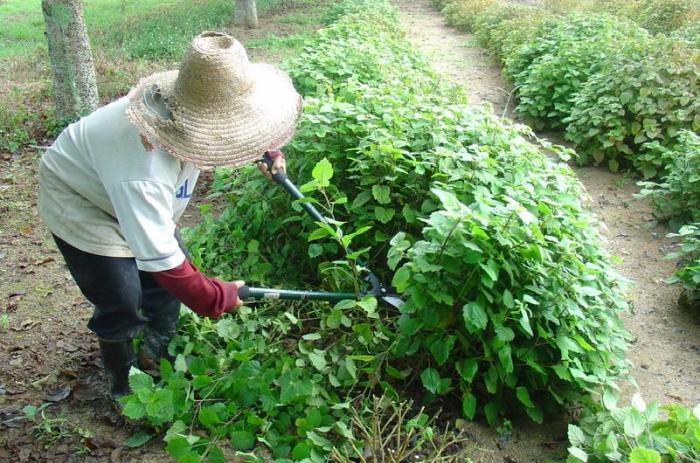
Estimated Cost of Production
The cost of producing one kilogramme of fresh P. cablin is about RM0.30 based on the yield of fresh leaves at 50 t/ha from the two harvests (main and ratoon crops) and the production cost of RM14,750/ha. The cost of producing one kilogramme of extracted oil is estimated about RM84 based on the yield of extracted oil at 325 kg/ha and the total production cost of RM27,200. The production cost was estimated based on the cost of current inputs during writing of this article. [9]
Chemical Constituent
Essential oil of P. cablin leaves has been reported to contain sesquiterpene (patchouli alcohol, patchoulol, pogostol, α-bulnesene, seychellene, α-guaiene, β-caryophyllene, β-elemene, α-patchoulene, β-patchoulene, λ- patchoulene). [13][14]
Essential oil of P. cabli unspecific parts has been reported to contain tetracyclic sesquiterpene (e.g. cycloseychellene), sesquiterpene (e.g. α-bulnesene, α-guaiene, seychellene, β-humulene, caryophyllene, α-patchoulenes, β-patchoulenes, γ-patchoulenes, patchouli alcohol, (-)-globulol, β-guaiene, trans-farnesol, isocaryophillene, caryophyllene oxide, βelemene, δguaiene, and aciphyllene). [15][16][17]
n-hexane extract of P. cablin dry leaves has been reported to contain patchouli alcohol, pogostol, stigmast-4-en-3-one, retusin, and pachypodol. [18]
Methanol extract of P. cablin has been reported to contain flavovoid (e.g. 7,3′-di-O-methyleriodictyol, 7,3′,4′-tri-O-methyleriodictyol, 3,7,4′-tri-O-methylkaempferol, ombuine, pachypodol, kumatakenin). [19]
Acetone extract of P. cablin has been reported to contain sesquiterpene hydroperoxides (e.g. 10α-hydroperoxyguaia-1,11-diene, 1α-hydroperoxy-guaia-10(15),11-diene and 15α-hydroperoxy-guaia-1(10),11-diene). [20]
Pressurized liquid extract of P. cablin has been reported to contain β-patchoulene, caryophyllene, α-guaiene, seychellene, β-guaiene, δ-guaiene, spathulenol, patchouli alcohol and pogostone. [21]
Cytotoxicity-guided fractionation of P. cablin aerial parts has been reported to contain Licochalcone A, ombuin, and 5,7-dihydroxy-3′,4′-dimethoxyflavanone. [22]
Plant Part Used
Leaves, aerial parts and whole plant. [6][23][24]
Traditional Use
In Philippines, P. cablin has been traditionally used for musculoskeletal disorders [25]. The plant is used to calm the nerves and enhances sexual desire. The fragrance of patchouli is said to improve concentration, calm the nerves, and ease depression. It can either be calming (in mild concentrations) or stimulating (in heavier concentrations). The earthy, musky scent of patchouli is reputed to stimulate and enhance sexual desire [26]. P. cablin has been used in the East to ward off infectious diseases, to treat fever, cold, nausea, vomiting, diarrhoea, abdominal pain, bad breath, headaches, snake and insect bites; as an insecticide. Traditionally valued as an aphrodisiac, it is used in perfumes and to perfume textiles in India and the Arabs [27].
Practitioners of traditional Chinese medicine use the whole plant to treat headache, stomach gas, vomiting and diarrhoea. [23]
The leaves poultice can be used to aid in treatment of abscess, headache by applying it on problematic areas. Drinking the decoction or the juice from the leaves is good for cough and asthma. Other than that, the leaves are inserted in the water for bathing or used as talc for its strong scent [24] as it was said that decoction of the leaves is good to reduce body odour [6].
The essential oil of P. cablin is an important ingredient in the perfumery industry. It can be found in many famous brands of perfumes. There are no synthethic chemical that similar to this plant’s essential oil. It also has therapeutic properties such as antidepressant, antiseptic, aphrodisiac, astringent, cytophylactic, deodorant and fungicide. P. cablin is also widely used in scented industrial product such as laundry detergent, air fresheners and also paper towels. In flavouring industry, P. cablin acts as a flavour ingredient in major food products. [11]
Preclinical Data
Pharmacology
Cytotoxic activity
Licochalcone A isolated from extract of P. cablin aerial parts treated to promyelocytic leukemia cells (HL-60) showed cytotoxicity and inhibition of PI-PLC gamma 1 activity by inducing terminal differentiation with generation of monocyte using non-specific acid esterase assay. [22]
Both 7,4′-di-O-methyleriodictyol and 3,7,4′-tri-O-methylkaempferol isolated from methanol extract of P. cablin suppressed the umu gene expression of SOS response (a global response to DNA damage) (> 50% suppression) in Salmonella typhimurium TA 1535/pSK1002 against metagen 2-(2-furyl)-3-(5-nitro-2-furyl)acrylamide (furylfuramide). [19]
Antiemetic activity
All patchouli alcohol, pgostol, stigmast-4-en-3-one, retusin, and pachypodol isolated from n-hexane extract of P. cablin (10, 20, 50, 70 mg/kg) administered abdominally to sulfate-induced emesis in young male chicks (25-35 g) showed antiemetic activity in a dose-dependent manner. [18]
Antioxidant activity
Aqueous extract of P. cablin (1 mg/mL) treated to hydrogen peroxide necrotic and apoptotic cell death induced-human neuroglioma cell line A172 inhibited the scavenging activity of reactive oxygen species (ROS) compared to superoxide dismutase (200 U/mL), catalase (200 U/mL) and dimethylthiourea (10 mM). The mechanism of action is via prevention of ATP depletion and activation of poly ADP-ribose polymerase.This extract also prevented H2O2-induced release of cytochrome C into cytosol. [28]
Patchouli alcohol isolated from essential oil of P. cablin (500 μg/mL) showed moderate antioxidant activity (56-72% hexanal oxidation inhibition) after 40 days using aldehyde/carboxylic acid assay. [29]
Platelet activating factor (PAF) inhibition activity
A sesquiterpenoid (α-bulnesene) isolated from aqueous extract of P. cablin administered to platelet-activating factor (PAF) and arachidonic acid induced platelet aggregation in New Zealand White rabbit inhibited the binding of [(32)H]PAF on the PAF receptor and increased the intracellular Ca2+ in fluo-3/AM-loaded platelets in a dose-dependent manner. This compound also inhibited AA-induced thromboxane B(2)(TXB(2) and prostaglandin E2 formations. [30][31]
Analgesic activity
Methanol extract of P. cablin aerial part and leaves (0.5 and 1.0 g/kg) administered orally 60 min before induction of acetic acid for writhing responses and formalin for paw licking to Imprinting Control Region (ICR) mice (18-22 g) decreased the writhing responses at dose 1.0 g/kg extract and reduced the nociception at dose of 0.5 and 1.0 g/kg. [32]
Anti-inflammatory activity
Methanol extract of P. cablin aerial part and leaves (0.5 and 1.0 g/kg) administered orally to λ-carrageenan (Carr)-induced paw oedema to ICR mice (18-22 g) 120 minutes after Carr injection reduced paw oedema inflammation in a dose-dependent manner. The extract also decreased the level of malondialdehyde in the oedematous paw by increasing the activities of antioxidant enzymes in the liver such as superoxide dismutase, glutathione peroxidase and glutathione reductase as well as decreasing the cyclo-oxidase 2 and tumour necrosis factor-alpha activities of the oedematous paw. [32]
Antimicrobial activity
Trypanocidal activity
Sesquiterpene hydroperoxides (10α-hydroperoxyguaia-1,11-diene, 1α-hydroperoxy-guaia-10(15),11-diene and 15α-hydroperoxy-guaia-1(10),11-diene) isolated from extract of P. cablin respectively showed trypanocidal activity against epimastigotes of Trypanosoma cruziwere with minimum lethal concentrations (MLC) of 0.84-1.7 μM). [20]
Antibacterial
Essential oil of P. cablinshowed antibacterial activity against Campylobacter jejuni and Listeria monocytogenes with bactericidal activity (BA50) (0.003- 0.007 and 0.02-0.04 respectively). [33]
Essential oil of P. cablin showed antibacterial activity against 20 types of bacteria strain including Gram-positive cocci and rods and Gram-negative rods which are Staphylococcus aureus SP-1 (Inhibition zone diameters = 20 mm), Bacillus brevis RB-3 (19 mm), B. circulans RB-6 (17 mm), Citrobacter sp. VR-14 (17 mm), Escherichia coli VR-12 (17 mm), E. coli VR-17 (24 mm), E. coli SP-11 (17 mm), Klebsiella sp. VR-13 (20 mm), Salmonella typhi VR-20 (28 mm), S. typhimurium VR-19 (10 mm), Shigella boydii VR-15 (9 mm), Pseudomonas aeruginosa VR-6 (11 mm), P. aeruginosa SP-10 (20 mm), Vibrio cholera VR-65 (26 mm), V. cholera VR-75 (23 mm), V. cholera VR-78 (25 mm), V. cholera VR-80 (25 mm), and plant pathogen (GNR) BB-212 (23 mm), GNR FB-209 (18 mm) and GNR PB-203 (24 mm) using disc diffusion method. [34]
Antifungal
Essential oil of P. cablin inhibited the growth of 12 different types of fungi (Alternaria citii, Aspergillus furnigatus, A. oryzae, Candida albicans, Cryptococcus neoformans, Fusarium oxysporum, F. solani, Helminthosporium compactum, Macrophomina phaseolina, Sclerotium rolfsii, Sporothrix schenkii and Rrichophyton mentagrophytes) using disc diffusion method. [34]
Toxicity
No documentation.
Clinical Data
No documentation.
Dosage
No documentation.
Poisonous Management
No documentation.
Line drawing
No documentation.
References
- The Plant List. Pogostemon cablin (Blanco) Benth. 2013 ver1.1 [homepage on the internet]. c2012 [updated 2012 March 23; cited 2014 Nov 17] Available from: http://www.theplantlist.org/tpl1.1/record/kew-162094
- Philippines medicinal plants.Pogostemon cablin (Blanco) Benth. [homepage on the internet]. c2014 [updated 2014; cited 2014 Nov 17] Available from: http://www.stuartxchange.com/Kabling.html
- Hanelt P, editor. Mansfeld’s encyclopedia of agricultural and horticultural crops. Volume 2. Berlin: Springer-Verlag, 2001; p. 1967.
- Oyen LPA. Pogostemon Desf. In: Oyen LPA, Nguyen Xuan Dung, editors. Plant Resources of South-East Asia No. 19: Essential-oil plants. Leiden, Netherlands: Backhuys Publisher, 1999; p. 151-157.
- National Institute of Materia Medica Hanoi-Vietnam. Selected medicinal plants in Vietnam. Vol. II. Hanoi: Science and technology publishing house, 1999; p. 179.
- Hariana HA. Tumbuhan obat dan khasiatnya. Seri Kedua. Jakarta: Niaga Swadaya, 2008; p. 145.
- Burkill IH. A dictionary of the economic products of the Malay Peninsula. Volume 2. London: Published on behalf of the governments of the Straits settlements and Federated Malay states by the Crown agents for the colonies, 1935; p. 1782.
- US National Plant Germplasm System. Pogostemon cablin (Blanco) Benth. [homepage on the internet]. No date [cited 2016 Oct 20]. Available from: https://npgsweb.ars-grin.gov/gringlobal/taxonomydetail.aspx?id=29154
- Azmil ARI, Ahmad W. Nilam (Pogostemon cablin). In: Musa Y, Muhammad Ghawas M, Mansor P, editors. Penanaman tumbuhan ubatan & beraroma. Selangor, Malaysia: MARDI, 2005; p. 118-123.
- Skaria BP, Joy PP, Mathew S, Mathew G, Joseph A, Joseph R. Aromatic plants Vol 01. Horticulture science series. New Delhi: New India Publishing Agency, 2007; p. 127.
- Ramya HG, Palanimuthu V, Rachna S. An introduction to patchouli (Pogostemon cablin Benth.) – A medicinal and aromatic plant: It’s importance to mankind. Agric Eng Int: CIGR Journal. 2013;15(2):243-250.
- Ahmad AW, Azmil ARI, Noh MJ, editors. Production and processing of essential oils crops (tea-tree, patchouli, kesum and vanilla). Proceeding of International Conference and Exhibition on Herbs; 1999 November 9-10; Serdang, Selangor: Institut Penyelidikan dan Kemajuan Pertanian Malaysia (MARDI), 1999; p. 68-74
- Blank AF, Sant’ana TCP, Santos PS, et al. Chemical characterization of the essential oil from patchouli accessions harvested over four seasons. Ind Crops Prod. 2011;34(1):831-837.
- Henderson W, Hart JW, How P, Jidge J. Chemical and morphological studies on sites of sesquiterpene accumulation in Pogostemon cablin (patchouli). Phytochemistry. 1970;9(6):1219-1228.
- Chen Y, Wu Y-G, Xu Y, et al. Dynamic accumulation of sesquiterpenes in essential oil of Pogostemon cablin. Rev Bras Farmacogn. 2014;24(6):626-634.
- Luo J, Guo X, Feng Y. [Constituents analysis on volatile oil of Pogostemon cablin from different collection time cultivated in Hainan]. Zhong Yao Cai. 2002;25(1):21-23. Chinese.
- Terhune SJ, Hogg JW, Lawrence BM. Cycloseychellene, a new tetracyclic sesquiterpene from Pogostemon cablin. Tetrahedron Lett. 1973;47:4705-4706.
- Yang Y, Kinoshita K, Koyama K, et al. Anti-emetic principles of Pogostemon cablin (Blanco) Benth. Phytomedicine. 1999;6(2):89-93.
- Miyazawa M, Okuno Y, Nakamura S-i, Kosaka H. Antimutagenic activity of flavonoids from Pogostemon cablin. J Agric Food Chem. 2000;48(3):642-647.
- Kiuchi F, Matsuo K, Ito M, Qui TK, Honda G. New sesquiterpene hydroperoxides with trypanocidal activity from Pogostemon cablin. Chem Pharm Bull. 2004;52(12):1495-1496.
- Hu LF, Li SP, Cao H, et al. GC–MS fingerprint of Pogostemon cablin in China. J Pharm Biomed Anal. 2006;42(2):200-206.
- Park EJ, Park HR, Lee JS, Kim J. Licochalcone A: An inducer of cell differentiation and cytotoxic agent from Pogostemon cablin. Planta Med. 1998;64(5):464-466.
- Balick M. Rodale’s 21st century herbal: A practice guide for healthy living using nature’s most powerful plants. New York: Rodale Publication, 2014; p. 239.
- Musa Y, Azimah K, Zaharah H. Tumbuhan ubatan popular Malaysia. Serdang, Selangor: MARDI, 2009; p. 73.
- Tantiado RG. Survey on Ethnopharmacology of medicinal plants in Iloilo, Philippines. Int J Biosci Biotechnol. 2012;4(4):11-26.
- Zand J, Spreen AN, LaValle JB. Smart medicine for healthier living. New York: Penguin Publications, 1999; p. 45.
- Pitman V. Aromatherapy: A practical approach. Cheltenham, UK: Nelson Thornes, 2004; p. 276.
- Kim HW, Cho SJ, Kim BY, Cho SI, Kim YK. Pogostemon cablin as ROS Scavenger in Oxidant-induced Cell Death of Human Neuroglioma Cells. Evid Based Complement Alternat Med. 2010;7(2):239-247.
- Wei A, Shibamoto T. Antioxidant activities and volatile constituents of various essential oils. J Agric Food Chem. 2007;55(5):1737-1742.
- Hsu HC, Yang WC, Tsai WJ, Chen CC, Huang HY, Tsai YC. Alpha-bulnesene, a novel PAF receptor antagonist isolated from Pogostemon cablin. Biochem Biophys Res Commun. 2006;345(3):1033-1038.
- Tsai YC, Hsu HC, Yang WC, Tsai WJ, Chen CC, Watanabe T. Alpha-bulnesene, a PAF inhibitor isolated from the essential oil of Pogostemon cablin. Fitoterapia. 2007;78(1):7-11.
- Lu TC, Liao JC, Huang TH, et al. Analgesic and anti-inflammatory activities of the methanol extract from Pogostemon cablin. Evid Based Complement Alternat Med. 2011;8(1):1-9.
- Friedman M. Bactericidal activities of plant essential oils and some of their isolated constituents against Campylobacter jejuni, Escherichia coli, Listeria monocytogenes and Salmonella enterica. J Food Prot. 2002;65(10):1545-1560.
- Pattnaik S. Antibacterial and antifungal activity of ten essential oils in vitro. Microbios. 1996;86(349):237-246.


